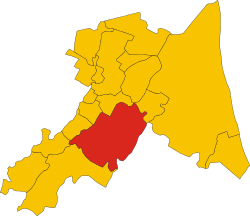Faventia
| Faenza | |
|---|---|
| Comune | |
| Città di Faenza | |
 |
|
 Faenza within the Province of Ravenna |
|
| Location of Faenza in Italy | |
| Coordinates: 44°17′N 11°53′E / 44.283°N 11.883°ECoordinates: 44°17′N 11°53′E / 44.283°N 11.883°E | |
| Country | Italy |
| Region | Emilia-Romagna |
| Province / Metropolitan city | Ravenna (RA) |
| Frazioni | Albereto, Borgo Tuliero, Celle, Cosina, Granarolo, Mezzeno, Pieve Cesato, Pieve Ponte, Prada, Reda, Sant'Andrea |
| Government | |
| • Mayor | Giovanni Malpezzi (Democratic Party) |
| Area | |
| • Total | 215.72 km2 (83.29 sq mi) |
| Elevation | 34 m (112 ft) |
| Population (31 December 2012) | |
| • Total | 58,204 |
| • Density | 270/km2 (700/sq mi) |
| Demonym(s) | Faentini |
| Time zone | CET (UTC+1) |
| • Summer (DST) | CEST (UTC+2) |
| Postal code | 48018 |
| Dialing code | 0546 |
| Patron saint | Madonna of the Graces |
| Saint day | June 17 |
| Website | Official website |
Faenza (Italian pronunciation: [faˈɛntsa]; Latin: Faventia) is an Italian city and comune, in the province of Ravenna, Emilia-Romagna, situated 50 kilometres (31 miles) southeast of Bologna.
Faenza is noted for its manufacture of majolica-ware glazed earthenware pottery, known from the name of the town as faience.
Faenza, at the foot of the first Subapennine hills, is surrounded by an agricultural region including vineyards in the hills, and cultivated land with traces of the ancient Roman land-division system, and fertile market gardens in the plains. In the nearby green valleys of the rivers Samoggia and Lamone there are great number of 18th and 19th century stately homes, set in extensive grounds or preceded by long cypress-lined driveways.
According to mythology, the name of the first settlement, Faoentia, had Etruscan and Celtic roots, meaning in Latin "Splendeo inter deos" or "I shine among the gods," in modern English. The very name, coming from the Romans who developed this center under the name of Faventia, has become synonymous with ceramics (majolica) in various languages, including French (faïence) and English (faience).
Here Quintus Caecilius Metellus Pius defeated populares army of Gnaeus Papirius Carbo in 82 BC.
From the second half of the 1st century AD the city flourished considerably as a result of its agricultural propensities and the development of industrial activities such as the production of everyday pottery and brickwork objects and linen textiles.
...
Wikipedia

